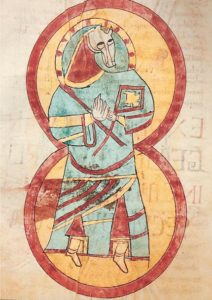Auction : Livres d’heures on Ebay
Sur Ebay, en ce moment, vente de Livres d’heures :

Manuscrit retiré de la vente ….
[Link]
BOOK OF HOURS, use of Rome, in Latin. ILLUMINATED MANUSCRIPT ON VELLUM [northern Italy, Ferrara, c. 1460] . 95 x 72 mm. FIVE 3-5 LINE ILLUMINATED INITIALS with leafy ornaments and extensions and marginal decoration; ONE 7 line HISTORIATED INITIAL with border.

[Link]
Manuscrits enluminés : expositions in USA
Les passionnés de l’enluminure et du manuscrit médiéval d’outre Atlantique auront l’occasion en cette année 2009 d’assister à une multitude d’expositions assez exceptionnelles. Pas moins de cinq musées organisent ou organiseront des manifestations en l’honneur du roi manuscrit :
Romance of the Rose : Visions of Love in Illuminated Medieval Manuscripts
Roman de la Rose : Visions de l’Amour dans les manuscrits médiévaux enluminés
Walters Art Museum, Baltimore, MD USA : January 24-April 19, 2009 [Link]
The Romance of the Rose, a 13th-century poem written in Old French, was among the most popular and influential literary texts of its day. The allegorical treatment of such an enduring subject as \ »Love\ » and the exploration of the notion of \ »Quest\ » make this focus show widely accessible to diverse audiences. The exhibition features nine different manuscripts of the Romance of the Rose drawn from collections in North America, along with a selection of medieval ivories from the Walters collection. The exhibition is a collaborative project between the Walters, Johns Hopkins University, and the Bibliotheque Nationale in Paris.
German and Central European Manuscript Illumination
J. Paul Getty Museum, Los Angeles, CA USA : February 24-May 24, 2009 [Link]
This exhibition explores the tradition of manuscript illumination—book painting using brilliant colors and precious metals—in Germany and central Europe. A beloved artistic medium, illumination began with the flowering of book production under Charlemagne in the early 800s and continued even after the invention of the printed book in the 1400s.

© J. Paul Getty Trust. Ms Ludwig XI, f. 12.
Heaven on Earth : Manuscript Illuminations from the National Gallery of Art
Walters Art Museum, Baltimore, MD USA : April 25-July 19, 2009 [Link]
Rare medieval manuscript illuminations, last exhibited in 1975, will be showcased in a stunning installation, Heaven on Earth: Manuscript Illuminations from the National Gallery of Art. This exhibition offers the first in-depth look at these rare medieval manuscript illuminations from 52 single leaves and 4 bound volumes, among them a number of important recent acquisitions, which date from the 12th to the 16th century and were made in France, Germany, Austria, Bohemia, the Netherlands, Spain, and Italy.
Prayers in code : Books of Hours from Renaissance France
Walters Art Museum, Baltimore, MD USA : April 25-July 19, 2009 [Link]
During the late Middle Ages, Books of Hours became common tools of private devotion and sought-after status symbols. Carried by fashionable ladies and collected by rich bibliophiles, Books of Hours differed greatly in style and ornament but were predictable in choice of pictures. The 24 manuscripts plus one painting in this exhibition will present unusual images that introduce a new fashion for emblems and rebuses (pictures depicted together to represent a word) while challenging our understanding of the relationship between the illustrations and the prayer text. With selected loans to complement the museum’s collection, this exhibition will explore the patronage at the court of King Francis I (1494–1547) during a time when the controversies over Humanism, Reformation and Orthodoxy shaped the intellectual life of discerning patrons.
Saturday May 23, 2009, 10 a.m.–5 p.m.
The Walters Art Museum, Baltimore
A symposium organized in conjunction with the loan exhibition “Prayers in Code: Books of Hours from Renaissance France,” April 25–July 17, 2009, at the Walters Art Museum.
Papers will address the vibrant exchange between artists, printers, and patrons in France in the fi rst half of the 16th century and explore book production during a time when controversies over humanism, reformation, and orthodoxy shaped the intellectual life of discerning patrons.
Organized by the Walters Art Museum in collaboration with the Charles Singleton Center for the Study of Pre-Modern Europe, with the generous support of an anonymous donor.
Free ; advance registration is required. To register please contact Kathryn Gerry at kgerry@thewalters.org. For more information visit the online calendar at www.thewalters.org.
Introduction
MARTINA BAGNOLI, the Walters Art Museum
10:10–10:40 • A Book for Prayer? Books of Hours in the Era of Manuscript and Print
VIRGINIA REINBURG, Boston College
10:40–11:10 • Double Vision : memory Places, Devices, and Devotion
REBECCA ZORACH, University of Chicago
11:10–11:40 • Enea Silvio Piccolomini in France and Humanism in Royal Circles before François I
ROBERT SCHINDLER, Freie Universität Berlin
11:40–12:30 • Roundtable discussion led by Kim Butler, American University
12:30–2:00 • Lunch and self-guided tour of exhibition
2:00–2:30 • Geoff roy Tory and the “Pictogrammar” of the Champ fleury
TOM CONLEY, Harvard University
2:30–3:00 • Emblems and Hours : Some \ » oughts on Early Modern Illustration
DANIEL RUSSELL, University of Pittsburgh
3:00–4:00 • Roundtable discussion led by Stephen Campbell, The Johns Hopkins University
Temptation and Salvation : The Psalms of King David
J. Paul Getty Museum, Los Angeles, CA USA : June 9-August 16, 2009 [Link]
This exhibition illustrates the various ways that medieval artists illustrated the Psalms,” says Elizabeth Morrison, curator of manuscripts. “At times they concentrated on the literal meaning of single verses, and at other times addressed broader themes, such as the role of the Psalms in preparing the Christian faithful for the Last Judgment.”
Temptation and Salvation : The Psalms of King David is co-curated by Mary Flannery, University of London, and Elizabeth Morrison, curator of manuscripts at the J. Paul Getty Museum
Pages of Gold : Medieval Illuminations from the Morgan
Morgan Library & Museum, New York, NY USA : June 19-September 13, 2009 [Link]
Approximately fifty best examples are shown in the exhibition, including those of Italian, English, French, Flemish, German, Hungarian and Spanish origin. Several of the leaves are on view for the first time. This exhibition is supported in part by a grant from the Virginia M. Schirrmeister Charitable Lead Annuity Trust.
Out-of-Bounds : Images in the Margins of Medieval Manuscripts
J. Paul Getty Museum, Los Angeles, CA USA : September 1-November 8, 2009 [Link]
Part of the genius of medieval art lies in its unique ability to combine serious and profound images with playful and witty ones. In illuminated manuscripts, a primary artistic medium of the Middle Ages, scenes in the margins of a page often comment on the paintings illustrating the text in the center. As often as they expand on the narrative, they poke fun at the lofty themes and, more broadly, at human foibles. Out-of-Bounds: Images in the Margins of Medieval Manuscripts explores the margins of medieval books and explains its wealth of subject matter: children playing games, romantic pursuits, men battling fantastic creatures, and composite figures—half-human, half-beast—that wend their ways through the sinuous foliage of the painted borders.
The Art of Illumination : The Limbourg Brothers and the Belles Heures of Jean de France, Duc de Berry
The Metropolitan Museum of Art, New York, NY USA: September 22, 2009-January 3, 2010 [Link]
Sources : Stan Parchin [Link]
Richard Kay : Pontificalia: A Repertory of Latin Manuscript Pontificals & Benedictionals
Pontificalia : A Repertory of Latin Manuscript Pontificals & Benedictionals (296 pages), compiled by Richard Kay, is permanently available for consultation online [Link pdf]
The main catalogue identifies 1249 manuscripts, with a summary description of each one–including contents, place and date of origin, destinary, decoration, music, owners, and size–together with a bibliography. In addition, three appendices list : relevant manuscripts the present location of which is unknown ; manuscripts that for some reason have been excluded from this catalogue ; and printed editions of pontificals and benedictionals. Although much further research is required to achieve an exhaustive census of these manuscripts, the present provisional compilation should ease the way for others.
Richard Kay
Professor of History Emeritus
The University of Kansas
Lawrence, KS 66044
skipkay/@/ku.edu
Support : KU ScholarWorks is a digital repository for scholarly work created by the faculty and staff of the University of Kansas

(c) IRHT/BM Autun. ms 129, f. 36v. Pontifical romain (1483-1500).
Bénédiction des vierges. Sources : Base Enluminures
Dr. Jörn Günther – Antiquariat (Hamburg) : Passion of Collecting
Dr. Jörn Günther – Antiquariat (Hamburg) présente en ligne sa nouvelle \ »brochure\ » : Passion of Collecting, selection of illuminated manuscripts, miniatures and illustrated early printed books.
J’y ai retenu le n° 5, un Livre d’heures à l’usage de Paris, ca 1400, sans doute commandité par un Breton. Les noms des saints Yves et Tugdual, présents au calendrier et aux litanies.
(c) Jörn Günther. f. 81, détail. L’Annonce aux bergers
Site web Dr. Jörn Günther [Lien]
PAGES ANNEXES
Auteur du blog : Jean-Luc DEUFFIC




